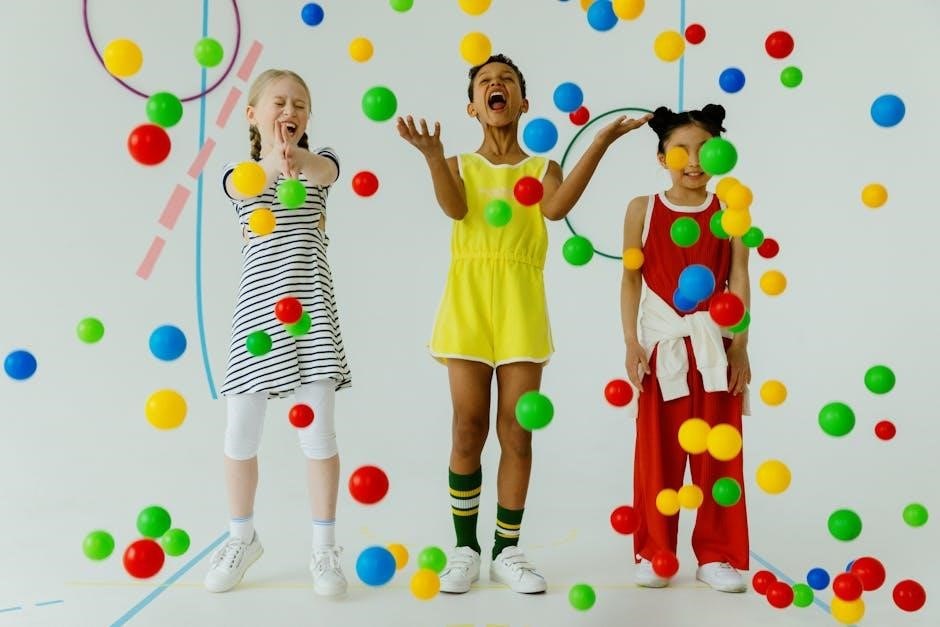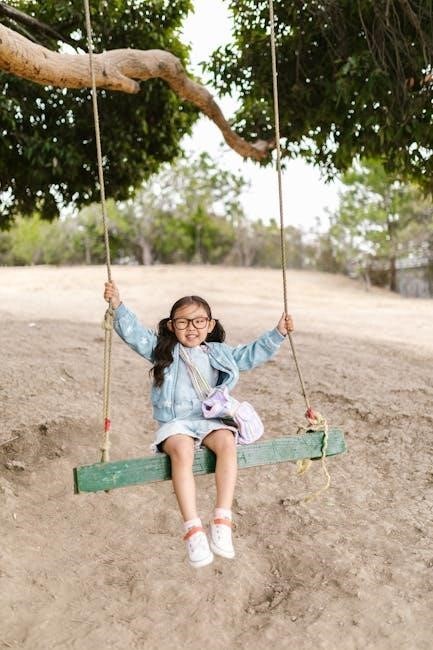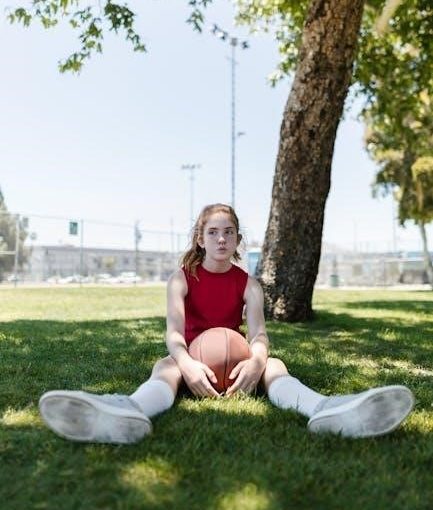Rajiv Joseph’s Gruesome Playground Injuries explores the complex, decades-long relationship between Kayleen and Doug, bound by physical and emotional scars. The title underscores the lasting impact of childhood wounds, both literal and metaphorical, shaping their intertwined lives over 30 years.
1.1 Overview of the Play
Gruesome Playground Injuries, written by Rajiv Joseph, is a darkly humorous and poignant exploration of friendship and trauma. The play follows Kayleen and Doug, childhood friends whose lives intersect over 30 years at pivotal, often painful moments. Through a nonlinear narrative, it examines how physical and emotional scars shape their bond. The title reflects the lasting impact of childhood injuries, both literal and metaphorical, as the characters navigate their shared history of suffering. This unconventional structure weaves together moments of tenderness, humor, and heartache, creating a deeply human story about connection and resilience.
1.2 Background and Context
Gruesome Playground Injuries, written by Rajiv Joseph, is a contemporary play that premiered in 2009. It explores themes of trauma, friendship, and resilience through the lives of Kayleen and Doug, whose relationship is defined by shared physical and emotional pain. The play’s nonlinear structure reflects the fragmented nature of memory and the cyclical impact of past injuries. Drawing from Joseph’s own experiences, the work resonates with audiences by blending dark humor with raw emotional depth. Its unique storytelling has made it a significant piece in modern theater, often studied for its bold narrative style and psychological complexity.
1.3 Significance of the Title
The title Gruesome Playground Injuries captures the essence of the play’s exploration of physical and emotional scars. The word “Gruesome” highlights the severity of the injuries, while “Playground” evokes childhood memories, suggesting that pain is an inherent part of growth. “Injuries” symbolizes both the external wounds and the internal traumas that shape the characters’ lives. The title reflects the play’s central theme of how shared suffering and resilience form the bond between Kayleen and Doug, emphasizing that their connection is rooted in both the literal and metaphorical “scars” they accumulate over time.

Plot and Structure
The play unfolds over 30 years, tracing the intersecting lives of Kayleen and Doug through pivotal, often painful moments. Its nonlinear structure emphasizes their shared history of injuries and resilience, creating a narrative that underscores the enduring bond formed through suffering and mutual understanding.
2.1 Nonlinear Narrative
The play employs a nonlinear narrative, jumping between key moments in Kayleen and Doug’s lives over three decades. This structure mirrors the fragmented nature of memory, where significant injuries and encounters shape their relationship. By presenting events out of chronological order, the playwright emphasizes the cyclical nature of their bond, highlighting how past wounds influence their present interactions. This unconventional approach creates a powerful emotional impact, inviting the audience to piece together their history alongside the characters.
2.2 Key Plot Points
The play unfolds through pivotal moments in Kayleen and Doug’s lives, beginning with their initial meeting at age eight in the school nurse’s office. Key plot points include Doug’s daredevil stunts, Kayleen’s vomiting incident, and their reunion at the high school prom, where Doug arrives injured. Another significant moment occurs when Doug, now in his 20s, sustains severe injuries from a motorcycle accident, while Kayleen, in her 30s, faces emotional turmoil. These incidents, spaced over 30 years, reveal how their bond is repeatedly tested by physical and emotional pain, creating a cycle of connection and separation that defines their relationship;
2.3 Character Development Over 30 Years
Kayleen and Doug’s characters evolve significantly over three decades, shaped by their shared experiences of pain and resilience. From their initial meeting at age eight, their interactions reveal vulnerabilities and coping mechanisms. Doug, the daredevil, often uses physical risks to mask emotional pain, while Kayleen internalizes her struggles, leading to self-destructive tendencies. Their relationship oscillates between friendship and unspoken romantic tension, with each reunion exposing deeper layers of their psyches. Over time, both characters confront the inevitability of change and the lasting impact of their bond, illustrating how scars, both physical and emotional, define their growth.
Main Characters
Kayleen and Doug are central to the narrative, their lives intertwining through shared injuries and emotional struggles. Their complex bond evolves over 30 years, defining the play’s core.
3.1 Kayleen and Doug: A Complex Relationship
Kayleen and Doug’s relationship is defined by their shared experiences of physical and emotional trauma; Their bond, forged through childhood injuries, evolves over 30 years, revealing a deep, often painful connection. Doug’s daredevil nature contrasts with Kayleen’s quieter struggles, creating a dynamic of mutual dependence. Their encounters, marked by injuries and life’s challenges, highlight a relationship that oscillates between affection and dysfunction. The scars they accumulate—both physical and emotional—serve as a testament to their enduring, yet fraught, connection.
3.2 Psychological Depth of Protagonists
Kayleen and Doug’s psychological complexity is revealed through their shared experiences of pain and resilience. Kayleen’s quiet struggles with emotional wounds contrast Doug’s outward physical injuries, creating a rich dynamic. Their interactions, spanning 30 years, expose deep-seated insecurities and unspoken feelings. The play delves into their inner worlds, showing how their bond is both a source of comfort and conflict. Their psychological growth is marked by moments of vulnerability, humor, and silence, illustrating the enduring impact of their shared suffering on their identities and relationships.
3.3 Supporting Characters and Their Roles
While Gruesome Playground Injuries primarily focuses on Kayleen and Doug, minor characters like nurses, teachers, and family members appear at pivotal moments. These figures serve to highlight the protagonists’ isolation and the lack of external support in their lives. Their roles are fleeting but impactful, often providing context to Kayleen and Doug’s injuries or emotional struggles. The absence of fully developed supporting characters underscores the play’s themes of loneliness and the enduring bond between the two leads, emphasizing their reliance on each other amidst life’s chaos.

Themes and Symbolism
The play explores themes of physical and emotional pain, using injuries as metaphors for inner scars. Shared suffering bonds Kayleen and Doug, symbolizing enduring connections despite life’s uncertainties.
4.1 Physical vs. Emotional Pain
In Gruesome Playground Injuries, physical harm and emotional trauma are deeply intertwined. The play uses scars and injuries as metaphors for the characters’ inner struggles, highlighting how outward wounds often mirror internal pain. Kayleen and Doug’s encounters are marked by both bodily harm and emotional distance, suggesting that physical pain can be a manifestation of unresolved emotional issues. The juxtaposition of their injuries over time reveals how some scars never fully heal, whether they are visible or hidden. This duality underscores the enduring impact of both kinds of pain on their relationship and personal growth.
4.2 The Bond of Shared Suffering
Gruesome Playground Injuries illustrates how shared suffering creates an unbreakable bond between Kayleen and Doug. Their encounters, marked by physical injuries and emotional turmoil, foster a unique connection. Each injury becomes a shared experience, strengthening their relationship despite its volatility. The play suggests that pain acts as a catalyst for intimacy, drawing the characters together at pivotal moments. Through their collective scars, they find understanding and comfort, revealing how shared suffering can transcend traditional notions of love and friendship. This bond is both a source of strength and a reminder of their enduring interdependence.
4.3 Existential Themes and Life’s Uncertainties
Gruesome Playground Injuries delves into existential themes, exploring life’s unpredictability and the inevitability of suffering. Through Kayleen and Doug’s recurring injuries and chance reunions, the play highlights the randomness of fate and the search for meaning in pain. Their bond, forged through shared misfortunes, underscores the human condition’s fragility. The play’s dark humor and stark realism emphasize the futility of escaping life’s uncertainties, suggesting that suffering is an inherent part of existence. This existential lens invites audiences to reflect on resilience, purpose, and the enduring impact of life’s unpredictability.
Script and Dialogue
The script features sharp, emotional dialogue, blending humor with dark undertones, creating a compelling narrative that explores deep emotional pain through raw, unfiltered conversations.
5.1 Unique Dialogue Style
The dialogue in Gruesome Playground Injuries is raw and unfiltered, reflecting the emotional intensity of Kayleen and Doug’s relationship. Rajiv Joseph’s script employs a unique blend of humor and pain, creating a rhythm that feels both natural and deeply unsettling. The conversations often shift between lighthearted banter and profound revelations, mirroring the characters’ complex emotional journeys. This style not only highlights their bond but also underscores the darker undertones of their interactions, making the dialogue a pivotal element in conveying the play’s themes of suffering and connection.
5.2 Emotional Intensity in Conversations
The conversations in Gruesome Playground Injuries are charged with emotional depth, often shifting between humor and raw vulnerability. Rajiv Joseph crafts dialogue that feels both spontaneous and layered, reflecting the characters’ inner turmoil. Kayleen and Doug’s interactions are fraught with unspoken feelings, their exchanges oscillating between playful teasing and profound revelations. This emotional intensity underscores their complex bond, making their interactions feel deeply human. The dialogue’s unpredictability mirrors the unpredictability of life, drawing audiences into the characters’ shared struggles and connections.
5.3 Humor and Dark Comedy Elements
Gruesome Playground Injuries seamlessly intertwines humor with dark, often unsettling themes. Rajiv Joseph uses wit and irony to lighten moments of intense emotional or physical pain, creating a balance that prevents the narrative from feeling overly bleak. The characters’ banter and absurd situations provide comic relief, while also highlighting the absurdity of their circumstances. This blend of humor and darkness not only enhances the play’s emotional complexity but also mirrors the resilience and coping mechanisms of its characters, making their struggles both poignant and relatable. This duality captivates audiences, offering a unique theatrical experience.

Productions and Stagings
Gruesome Playground Injuries has seen notable productions, including its regional premiere by Ensemble Theatre, directed by Sanaz Inanlou and Nazanin Fattahi, featuring Mahan Nasser Zare and Parmida Zarei. The play has been staged with intimate, confrontational designs, emphasizing its dark themes and emotional depth. Director Levi Fackrell’s interpretation highlighted the bond between love and pain, while Stanford Theater Lab’s production used heavy imagery to underscore the characters’ turbulent relationship.
6.1 Notable Stage Productions
Gruesome Playground Injuries has been staged in various productions, with Ensemble Theatre presenting its regional premiere. Directed by Sanaz Inanlou and Nazanin Fattahi, the play featured Mahan Nasser Zare and Parmida Zarei. Stanford Theater Lab also produced a notable version, emphasizing the connection between love and pain. Director Levi Fackrell’s approach highlighted the play’s dark intensity, while the cast delivered powerful performances. These stagings showcased the play’s ability to resonate with audiences through its raw exploration of human connection and suffering, proving its theatrical impact and emotional depth.
6.2 Set Design and Visual Elements
The set design in Gruesome Playground Injuries plays a pivotal role in reflecting the characters’ emotional and physical journeys. From the stark, clinical environment of the school nurse’s office to the evolving backdrops that mirror the passage of time, the visuals underscore the play’s thematic depth. Lighting and props, such as bandages, crutches, and scars, emphasize the physical and emotional toll of injuries. The minimalist yet evocative design creates an intimate atmosphere, drawing the audience into the raw, unflinching narrative. Visual elements like bloodstains and shattered glass symbolize the fragility of life and relationships, enhancing the play’s emotional impact and dark humor.
6.3 Directorial Approaches
Directors of Gruesome Playground Injuries often emphasize the play’s emotional intensity and dark humor through bold staging choices. Sanaz Inanlou and Nazanin Fattahi, for instance, focused on intimate, confrontational setups to highlight the raw connection between Kayleen and Doug. Levi Fackrell’s direction underscored the unpredictability of their relationship, using dynamic transitions to reflect the nonlinear narrative. The play’s unique dialogue style is often amplified by directors who encourage actors to explore the subtleties of pain and vulnerability. These approaches create a visceral, thought-provoking experience, drawing audiences into the characters’ tumultuous yet enduring bond.
Reception and Reviews
Gruesome Playground Injuries has received critical acclaim for its raw emotional depth and dark humor. Audiences and critics praise its unflinching exploration of pain and vulnerability, though some find its intensity challenging.
7.1 Critical Acclaim
Rajiv Joseph’s Gruesome Playground Injuries has garnered widespread critical acclaim for its bold exploration of human connection through suffering. Critics praise the play’s raw emotional intensity, dark humor, and unflinching portrayal of physical and emotional scars. The non-linear narrative structure and deeply nuanced characters, particularly Kayleen and Doug, have been highlighted as standout elements. Many reviewers commend the play’s ability to balance heartbreak with levity, creating a visceral theatrical experience. The dialogue’s sharp wit and the characters’ complexity have earned Joseph a reputation as a masterful storyteller, making Gruesome Playground Injuries a memorable and impactful work in contemporary theater.
7.2 Audience Reactions
Audiences have been deeply moved by the raw emotional journey of Gruesome Playground Injuries, often leaving theaters with a lingering sense of reflection. The play’s unflinching portrayal of pain and resilience resonates strongly, with many viewers finding solace in its honest depiction of human vulnerability. The dark humor and poignant dialogue have been particularly praised for their ability to balance heartbreak with levity. While some find the graphic descriptions unsettling, the majority appreciate the play’s bold exploration of shared suffering, making it a memorable and thought-provoking experience that lingers long after the curtain falls.
7.3 Controversies and Debates
Gruesome Playground Injuries has sparked debates due to its graphic content and intense emotional themes. Some critics argue the play’s dark humor and explicit depictions of injuries may be off-putting or even exploitative. Others defend it, stating its unflinching honesty sheds light on the long-term effects of trauma. Audiences are divided on whether the play trivializes pain or offers a necessary exploration of human resilience. These discussions highlight the work’s ability to provoke thought, making it a polarizing yet impactful piece in contemporary theater. Its bold approach ensures it remains a subject of lively debate among theater enthusiasts.

Connection to Real-Life Issues
Gruesome Playground Injuries reflects real-life concerns about playground safety, long-term effects of childhood trauma, and mental health. Its portrayal of physical and emotional scars resonates with universal experiences of pain and resilience, highlighting the lasting impact of early injuries on adult lives. The play’s themes mirror societal debates on safety measures and the psychological toll of accidents, making it deeply relatable and thought-provoking for audiences.
8.1 Playground Safety and Accidents
Gruesome Playground Injuries highlights the prevalence of childhood accidents and their lasting impact. The play uses physical harm as a metaphor for emotional pain, drawing attention to the frequency of playground injuries and their psychological toll. By depicting characters’ recurring mishaps, the narrative underscores the importance of safety measures and the need for awareness. The themes resonate with real-life concerns about inadequate supervision, hazardous equipment, and the long-term consequences of untreated wounds. This focus on accidents serves as a catalyst for exploring deeper emotional and societal issues.
8.2 Long-Term Effects of Childhood Injuries
Gruesome Playground Injuries examines how childhood accidents leave lasting emotional and physical scars. The play portrays how injuries, like Doug’s repeated harm, shape personalities and relationships. Kayleen’s struggles highlight the psychological toll of unresolved trauma. These injuries symbolize deeper pain, showing how childhood experiences influence adult behavior. The narrative underscores the long-term consequences of untreated wounds, both physical and emotional, reflecting real-life issues of mental health and the lingering impact of early-life adversity. This theme resonates with audiences, emphasizing the importance of addressing childhood traumas.
8.3 Mental Health and Trauma
The play delves into the psychological toll of trauma, as Doug and Kayleen’s injuries mirror their inner turmoil. Their bond, forged through shared suffering, reveals how trauma can both connect and isolate individuals. Doug’s self-destructive behavior and Kayleen’s emotional detachment highlight the lasting impact of unresolved pain. The narrative explores how mental health struggles often stem from childhood experiences, showcasing the characters’ attempts to cope with their scars; This theme underscores the profound connection between physical wounds and emotional well-being, making it a poignant commentary on trauma’s enduring legacy. The play’s portrayal resonates deeply, emphasizing the complexity of mental health journeys.

Educational and Theatrical Value
Gruesome Playground Injuries is widely studied in theater programs for its complex themes and nonlinear narrative, offering insights into human relationships and trauma. Its theatrical intensity makes it a powerful teaching tool for exploring deep emotional and psychological dynamics, while its unique structure challenges actors and directors to innovate in storytelling and character portrayal, enriching both educational and performance experiences.
9.1 Use in Theater Studies
Gruesome Playground Injuries is a valuable tool in theater studies for its exploration of complex themes, nonlinear narrative, and deep character development. The play’s structure, which jumps through time, challenges students to analyze storytelling techniques and character arcs. Its focus on emotional and physical trauma provides rich material for exploring psychological depth and relational dynamics. Theater programs often use the play to teach actors how to portray multifaceted emotions and directors how to handle nonchronological storytelling. Additionally, its themes of pain, connection, and existential uncertainty spark meaningful discussions in academic settings, making it a compelling choice for dramatic analysis and performance practice.
9.2 Themes for Discussion
Gruesome Playground Injuries offers a multitude of themes for discussion, including the interplay between physical and emotional pain, the enduring bonds formed through shared suffering, and existential reflections on life’s unpredictability. The play’s nonlinear structure invites conversations about memory, trauma, and how experiences shape identity. Its exploration of human resilience and vulnerability provides a rich foundation for analyzing the complexities of relationships and the ways pain, both visible and invisible, connects us. These themes resonate deeply, making the play a compelling subject for academic and theatrical exploration.
9.3 Performances in Educational Settings
Gruesome Playground Injuries is frequently performed in educational settings due to its emotional depth and complex themes, making it a valuable tool for theater studies. Its nonlinear structure and exploration of human resilience offer students insights into character development and narrative techniques. The play’s intense dialogue and dark humor also provide challenging material for young actors to master. Educational productions often spark discussions about pain, relationships, and existential themes, enriching students’ understanding of dramatic storytelling. Its suitability for intimate staging makes it a popular choice for school and university theaters, fostering both artistic growth and emotional engagement.

Legacy and Impact
Rajiv Joseph’s Gruesome Playground Injuries has left a lasting mark on contemporary theater, influencing dark comedy and emotional storytelling. Its exploration of pain and resilience continues to resonate culturally, inspiring future adaptations and interpretations that reflect its timeless themes.
10.1 Influence on Contemporary Theater
Rajiv Joseph’s Gruesome Playground Injuries has significantly influenced contemporary theater through its unique narrative structure and dark humor. The play’s nonlinear storytelling and exploration of emotional and physical scars have inspired many playwrights to experiment with unconventional narratives. Its blend of comedy and tragedy has set a new standard for emotional depth in modern plays, making it a benchmark for innovative storytelling. Theaters worldwide have adopted similar themes, showcasing the play’s profound impact on the evolution of dramatic writing and stage productions.
10.2 Cultural and Social Relevance
Gruesome Playground Injuries resonates deeply with contemporary audiences by exploring universal themes of pain, resilience, and human connection. The play’s focus on both physical and emotional scars mirrors societal concerns about mental health and trauma. Its portrayal of flawed, relatable characters fosters empathy and encourages dialogue about the long-term effects of suffering. By addressing these issues with raw honesty and dark humor, the play has become a cultural touchstone, sparking conversations about vulnerability and the enduring bonds formed through shared adversity.
10.3 Future Adaptations and Interpretations
Gruesome Playground Injuries holds immense potential for future adaptations, with its universal themes of pain and connection transcending mediums. A film adaptation could amplify its emotional depth, while experimental stagings might push its nonlinear narrative further. Directors could explore multimedia elements to visualize the characters’ scars and memories. The play’s raw honesty also lends itself to reinterpretation through different cultural lenses, offering fresh perspectives on its exploration of human resilience. Its enduring relevance ensures it will continue to inspire new artistic interpretations and collaborations, keeping its message alive for future audiences.
